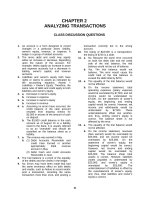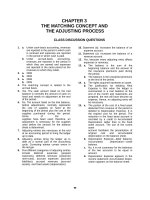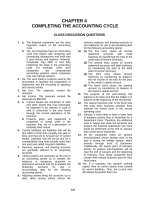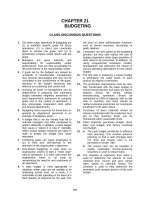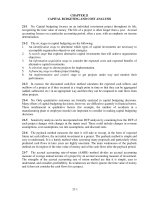Accounting26th ch 21
Bạn đang xem bản rút gọn của tài liệu. Xem và tải ngay bản đầy đủ của tài liệu tại đây (278.4 KB, 30 trang )
CHAPTER
Cost Behavior and CostVolume-Profit Analysis
Accounting
26e
Warren
Reeve
Duchac
©2016
Cost Behavior
• Cost behavior is the manner in which a cost changes as
•
a related activity changes.
Understanding the behavior of a cost depends on the
following:
o
o
Identifying the activities (activity bases) that cause the cost to
change.
Specifying the range of activity (relevant range) over which
the changes in the cost are of interest.
• Costs are normally classified as variable costs, fixed
costs, or mixed costs.
©2016
Variable Costs
• Variable costs are costs that vary in proportion to
•
changes in the activity base.
When the activity base is units produced, direct
materials and direct labor costs are normally
classified as variable costs.
©2016
Fixed Costs
• Fixed costs are costs that remain the same in total
•
dollar amount as the activity base changes.
When the activity base is units produced, many
factory overhead costs such as straight-line
depreciation are classified as fixed costs.
©2016
Mixed Costs
• Mixed costs are costs that have characteristics of both
•
a variable and a fixed cost. Mixed costs are
sometimes called semivariable or semifixed costs.
The high-low method is a cost estimation method that
may be used to separate mixed costs into their fixed
and variable components.
©2016
Summary of Cost Behavior Concepts
• One method of reporting variable and fixed costs is
called variable costing or direct costing.
o
o
Under variable costing, only the variable manufacturing
costs (direct materials, direct labor, and variable factory
overhead) are included in the product cost.
The fixed factory overhead is treated as an expense of the
period in which it is incurred.
©2016
Cost-Volume-Profit Relationships
• Cost-volume-profit analysis is the examination of the
relationships among selling prices, sales and
production volume, costs, expenses, and profits.
©2016
Contribution Margin
• Contribution margin is the excess of sales over
variable costs, computed as follows:
Contribution Margin = Sales – Variable Costs
• Contribution margin covers fixed costs. Once the fixed
costs are covered, any additional contribution margin
increases income from operations.
©2016
Contribution Margin Ratio
(slide 1 of 2)
• The contribution margin ratio, sometimes called the
•
profit-volume ratio, indicates the percentage of each
sales dollar available to cover fixed costs and to
provide income from operations.
The contribution margin ratio is computed as follows:
Contribution Margin
Contribution Margin Ratio =
Sales
©2016
Contribution Margin Ratio
(slide 2 of 2)
• The contribution margin ratio is most useful when the
increase or decrease in sales volume is measured in
sales dollars. In this case, the change in sales dollars
multiplied by the contribution margin ratio equals the
change in income from operations, computed as
follows:
©2016
Unit Contribution Margin
• The unit contribution margin is useful for analyzing the
•
profit potential of proposed decisions.
The unit contribution margin is computed as:
Unit Contribution Margin = Sales Price per Unit – Variable Cost per Unit
• The unit contribution margin is most useful when the
increase or decrease in sales volume is measured in
sales units (quantities). In this case, the change in sales
volume (units) multiplied by the unit contribution
margin equals the change in income from operations,
computed as follows:
©2016
Break-Even Point
(slide 1 of 2)
• The break-even point is the level of operations at
•
•
which a company’s revenues and expenses are equal.
At break-even, a company reports neither income nor
a loss from operations.
The break even-point in sales units is computed as
follows:
Fixed Costs
Break-Even Sales (units) =
Unit Contribution Margin
©2016
Break-Even Point
(slide 2 of 2)
• The break-even point in sales dollars can be
determined directly as follows:
Fixed Costs
Break-Even Sales (dollars) =
Contribution Margin Ratio
o
The contribution margin ratio can be computed using the unit
contribution margin and unit selling price as follows:
Unit Contribution Margin
Contribution Margin Ratio =
Unit Selling Price
©2016
Effect of Changes in Fixed Costs
• Fixed costs do not change in total with changes in the
•
level of activity. However, fixed costs may change
because of other factors such as advertising
campaigns, changes in property tax rates, or changes
in factory supervisors’ salaries.
Changes in fixed costs affect the break-even point as
follows:
o
o
Increases in fixed costs increase the break-even point.
Decreases in fixed costs decrease the break-even point.
©2016
Effect of Changes in Unit Variable Costs
•
•
Unit variable costs do not change with changes in the level of
activity. However, unit variable costs may be affected by other
factors such as changes in the cost per unit of direct materials,
changes in the wage rate for direct labor, or changes in the
sales commission paid to salespeople.
Changes in unit variable costs affect the break-even point as
follows:
o
o
Increases in unit variable costs increase the break-even point.
Decreases in unit variable costs decrease the break-even point.
©2016
Effect of Changes in Unit Selling Price
• Changes in the unit selling price affect the break-even
point as follows:
o
o
Increases in the unit selling price decrease the break-even
point.
Decreases in the unit selling price increase the break-even
point.
©2016
Target Profit
• The sales required to earn a target or desired amount
of profit is determined by modifying the break-even
equation as follows:
©2016
Cost-Volume-Profit (Break-Even) Chart
•
•
A cost-volume-profit chart, sometimes called a break-even chart, graphically shows
sales, costs, and the related profit or loss for various levels of units sold.
The cost-volume-profit chart is constructed using the following steps:
o
o
o
o
Step 1. Volume in units of sales is indicated along the horizontal axis. The range of volume
shown is the relevant range in which the company expects to operate. Dollar amounts of
total sales and total costs are indicated along the vertical axis.
Step 2. A total sales line is plotted by connecting the point at zero on the left corner of the
graph to a second point on the chart. The second point is determined by multiplying the
maximum number of units in the relevant range, which is found on the far right of the
horizontal axis, by the unit sales price. A line is then drawn through both of these points.
This is the total sales line.
Step 3. A total cost line is plotted by beginning with total fixed costs on the vertical axis. A
second point is determined by multiplying the maximum number of units in the relevant
range, which is found on the far right of the horizontal axis by the unit variable costs and
adding the total fixed costs. A line is then drawn through both of these points. This is the
total cost line.
Step 4. The break-even point is the intersection point of the total sales and total cost lines.
A vertical dotted line drawn downward at the intersection point indicates the units of sales
at the break-even point. A horizontal dotted line drawn to the left at the intersection point
indicates the sales dollars and costs at the break-even point.
©2016
Profit-Volume Chart
(slide 1 of 2)
• Another graphic approach to cost-volume-profit
analysis is the profit-volume chart, which plots only
the difference between total sales and total costs (or
profits).
o
In this way, the profit-volume chart allows managers to
determine the operating profit (or loss) for various levels of
units sold.
©2016
Profit-Volume Chart
(slide 2 of 2)
•
The profit-volume chart is constructed using the following steps:
o
o
o
o
o
Step 1. Volume in units of sales is indicated along the horizontal axis. The range
of volume shown is the relevant range in which the company expects to operate.
Dollar amounts indicating operating profits and losses are shown along the
vertical axis.
Step 2. A point representing the maximum operating loss is plotted on the
vertical axis at the left. This loss is equal to the total fixed costs at the zero level
of sales.
Step 3. A point representing the maximum operating profit within the relevant
range is plotted on the right.
Step 4. A diagonal profit line is drawn connecting the maximum operating loss
point with the maximum operating profit point.
Step 5. The profit line intersects the horizontal zero operating profit line at the
break-even point in units of sales. The area indicating an operating profit is
identified to the right of the intersection, and the area indicating an operating
loss is identified to the left of the intersection.
©2016
Assumptions of Cost-Volume-Profit Analysis
• Cost-volume-profit analysis depends on several
assumptions. The primary assumptions are as follows:
o
o
o
o
o
Total sales and total costs can be represented by straight
lines.
Within the relevant range of operating activity, the
efficiency of operations does not change.
Costs can be divided into fixed and variable components.
The sales mix is constant.
There is no change in the inventory quantities during the
period.
©2016
Sales Mix Considerations
(slide 1 of 2)
• Many companies sell more than one product at
•
different selling prices. In addition, the products
normally have different unit variable costs and, thus,
different unit contribution margins.
In such cases, break-even analysis can still be
performed by considering the sales mix.
o
The sales mix is the relative distribution of sales among the
products sold by a company.
©2016
Sales Mix Considerations
(slide 2 of 2)
• For break-even analysis, it is useful to think of the
•
•
individual products as components of one overall
enterprise product.
The unit selling price of the overall enterprise product
equals the sum of the unit selling prices of each
product multiplied by its sales mix percentage.
Likewise, the unit variable cost and unit contribution
margin of the overall enterprise product equal the
sum of the unit variable costs and unit contribution
margins of each product multiplied by its sales mix
percentage.
©2016
Operating Leverage
(slide 1 of 2)
• The relationship between a company’s contribution
•
margin and income from operations is measured by
operating leverage.
A company’s operating leverage is computed as
follows:
Contribution Margin
Operating Leverage =
Income from Operations
o
The difference between contribution margin and income
from operations is fixed costs.
Thus, companies with high fixed costs will normally have high
operating leverage.
©2016
Operating Leverage
(slide 2 of 2)
• Operating leverage can be used to measure the
•
impact of changes in sales on income from operations.
Using operating leverage, the effect of changes in
sales on income from operations follows:
©2016



